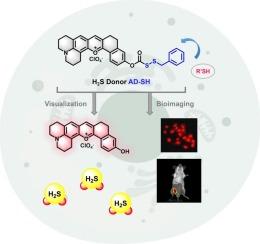A thiol-activated near-infrared fluorescent H2S donor for visualizing H2S release and its applications
IF 4.6
2区 化学
Q1 SPECTROSCOPY
Spectrochimica Acta Part A: Molecular and Biomolecular Spectroscopy
Pub Date : 2025-09-21
DOI:10.1016/j.saa.2025.126976
引用次数: 0
Abstract
Hydrogen sulfide (H2S), a critical endogenous signaling molecule, is involved in diverse physiological processes, and H2S donors have emerged as promising therapeutic agents. While organic donors address the uncontrolled release limitations of inorganic counterparts, most thiol-activated systems depend exclusively on cysteine (Cys), risking cellular thiol imbalance. To overcome this limitation, we developed AD-SH, a novel benzopyran salts-based NIR fluorescent H2S donor responsive to multiple biothiols. AD-SH exhibits high selectivity and sensitivity toward all intracellular biothiols (e.g., cysteine, glutathione, and homocysteine) without preferentially depleting a single Cys. Importantly, its near-infrared (NIR) fluorescence enables real-time tracking and visualization of H2S release. With excellent biocompatibility, photostability, and in vivo imaging performance in mice, AD-SH demonstrates its strong potential for live-cell imaging and dynamic H2S release tracking.

硫醇活化的近红外荧光H2S供体及其应用
硫化氢(H2S)是一种重要的内源性信号分子,参与多种生理过程,H2S供体已成为有前景的治疗药物。虽然有机供体解决了无机对应物不受控制的释放限制,但大多数硫醇激活系统完全依赖于半胱氨酸(Cys),有细胞硫醇失衡的风险。为了克服这一限制,我们开发了AD-SH,一种新型的苯并吡喃盐基近红外荧光H2S供体,对多种生物硫醇有反应。AD-SH对所有细胞内生物硫醇(如半胱氨酸、谷胱甘肽和同型半胱氨酸)具有高选择性和敏感性,而不会优先消耗单个胱氨酸。重要的是,它的近红外(NIR)荧光可以实时跟踪和可视化H2S释放。AD-SH具有良好的生物相容性、光稳定性和小鼠体内成像性能,在活细胞成像和动态H2S释放跟踪方面显示出强大的潜力。
本文章由计算机程序翻译,如有差异,请以英文原文为准。
求助全文
约1分钟内获得全文
求助全文
来源期刊
CiteScore
8.40
自引率
11.40%
发文量
1364
审稿时长
40 days
期刊介绍:
Spectrochimica Acta, Part A: Molecular and Biomolecular Spectroscopy (SAA) is an interdisciplinary journal which spans from basic to applied aspects of optical spectroscopy in chemistry, medicine, biology, and materials science.
The journal publishes original scientific papers that feature high-quality spectroscopic data and analysis. From the broad range of optical spectroscopies, the emphasis is on electronic, vibrational or rotational spectra of molecules, rather than on spectroscopy based on magnetic moments.
Criteria for publication in SAA are novelty, uniqueness, and outstanding quality. Routine applications of spectroscopic techniques and computational methods are not appropriate.
Topics of particular interest of Spectrochimica Acta Part A include, but are not limited to:
Spectroscopy and dynamics of bioanalytical, biomedical, environmental, and atmospheric sciences,
Novel experimental techniques or instrumentation for molecular spectroscopy,
Novel theoretical and computational methods,
Novel applications in photochemistry and photobiology,
Novel interpretational approaches as well as advances in data analysis based on electronic or vibrational spectroscopy.

 求助内容:
求助内容: 应助结果提醒方式:
应助结果提醒方式:


